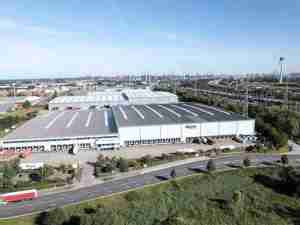The St. Lawrence Seaway, North America’s binational marine highway connecting the Atlantic Ocean to the Great Lakes, recently completed its best year for cargo shipments since 2007, reports the Great Lakes Seaway Partnership. With total cargo shipments of 40.9 million metric tons during the 2018 navigation season, St. Lawrence Seaway traffic increased nearly seven percent year-over-year. Additionally, total vessel transits were up nearly six percent over 2017.
“Total tonnage on the St. Lawrence Seaway exceeded the 5-, 10-, and 15-year averages, making 2018 an exceptionally strong shipping season, the best in over a decade,” says Craig H. Middlebrook, Deputy Administrator of the U.S. Saint Lawrence Seaway Development Corporation. “In particular, we were pleased to see heightened activity on the Seaway in December. Overall gains in year-over-year commodity increases were widespread, most notably in U.S. grain export trade. The investments in Seaway infrastructure and technology are achieving greater efficiencies for our customers and enhancing the binational waterway’s global competitiveness.”
The Top Ten Cargoes in 2018
The following top performing cargoes sustained Seaway traffic well above the five-year average:
Cargo
Metric Tons
Percent Increase*
1. Grain
12.1 million
20%
2. Dry Bulk
10.7 million
3%
3. Liquid Bulk
4.5 million
22%
4. Salt
3.5 million
5%
5. Coal
2.5 million
12%
6. Cement & Clinkers
1.9 million
14%
7. Steel Slabs
750,000
53%
8. Stone
564,000
24%
9. Gypsum
499,000
13%
10. Asphalt
383,000
50%
*All performance metrics above based on cargo traffic for the St. Lawrence Seaway only, excluding interlake traffic on the Great Lakes. Percentage increases compared to the same time last year.
Cargo Diversification & International Trade Raised the Tide
“The 2018 Navigation Season was an exceptional year for the Illinois International Port District (IIPD),” says Clayton Harris III, Executive Director, IIPD. “This is attributed to our diversification of cargo, which was enabled by empowering our maritime and logistics operator, North American Stevedoring Company, and maximizing the potential of Federal Trade Zone (FTZ) #22. These strategies encouraged more shippers to call on our port and bring more specialized cargo such as copper and aluminum than previous years.”
Collaboration Increases Economic Impact
“The port is as vibrant as ever,” says Paul C. LaMarre III, Port Director, Port of Monroe. “Our agile approach to multimodal logistics as well as our strategic partnerships established in 2018, have set the foundation for 2019.” The navigation season for the Port of Monroe began with an investment of $3.6 million in a new dock. This momentum continued with a new partnership with The Great Lakes Towing Company and Great Lakes Shipyard to establish towing and shipyard services at the port. The season concluded with bringing the IVER BRIGHT, a liquid asphalt tanker into port.
“For the port, this was the perfect way to end the season and it showcased all of our strategic partners and how a single new cargo can affect multiple stakeholders and collaboration drives economic impact. The Great Lakes Towing Company provided ice breaking services in the harbor; Central Marine Logistics Inc. & Inter Ship provided vessel operation services; Lakes Pilots Association provided pilotage services; and our multimodal logistics operator, DRM provided dock services. This contributed to a successful operation for our customer, the largest asphalt blending facility in the region, Michigan Paving & Materials.”
Agriculture Drives Growth
With 12.1 million metric tons of grain moved, a 20 percent increase YOY, agriculture was a key commodity in driving tonnage and international traffic in 2018. “We had a good year – aluminum tonnage was up 36 percent YOY and grain was up 325 percent YOY,” said William W. Scriber, Executive Director, Port of Oswego.
“Our focus has been on the expansion of both new business and strengthening the relationships with current customers. One example of that was the joint venture between the port and Perdue Agribusiness, where we created an expanded grain export system that won USDA’s approval and increased exports by 325 percent over 2017.”
Great Leadership on the Great Lakes
Ports across the Great Lakes-St. Lawrence Seaway System leveraged the multimodal, integrated system and collaborative approach of the community to drive tonnage and international traffic in 2018. Three American Great Lakes Ports also appointed new leadership:
• Deborah DeLuca became Executive Director of the Duluth Seaway Port Authority in August 2018
◦ DeLuca is the first woman to lead the organization in its 60-year history
◦ Previous professional experience includes the roles of Government & Environmental Affairs Director, Duluth Seaway Port Authority and President, DeLuca Strategies
• Adam Schlicht became Port Director of the Port of Milwaukee in May 2018
◦ Schlicht is the youngest Port Director in the history of the American Great Lakes Ports
◦ Previous professional experience includes the roles of Great Lakes Regional Representative as well as Senior Program Officer, Saint Lawrence Seaway Development Corporation
• William Scriber became Executive Director of the Port of Oswego Authority in December 2018
◦ Scriber is the first graduate of SUNY Oswego to run the port
◦ Previous professional experience includes the roles of Acting Executive Director, Port of Oswego and Commissioner of Elections, Oswego County Board of Elections; and Operations Manager, Air Express International and Voltainer Ocean Services









